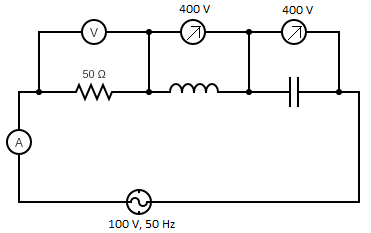
In the series LCR circuit, the voltmeter and ammeter readings are:

A) $V = 100\,V$, $I = 2\,A$
B) $V = 100\,V$, $I = 5\,A$
C) $V = 1000\,V$, $I = 2\,A$
D) $V = 300\,V$, $I = 1\,A$
Answer
172.2k+ views
Hint: In LCR circuit, if the resistor, inductor and capacitor is connected in series, then the voltmeter and ammeter readings can be determined by using the current and voltage formula. By using the voltage formula, the voltmeter reading can be determined, and by using the current formula the ammeter reading can be determined.
Formula used:
The expression for finding the reading of voltmeter is
$V = \sqrt {{V_R}^2 + {{\left( {{V_L} - {V_C}} \right)}^2}} $
Where, $V$ is the voltmeter reading, ${V_R}$ is the voltage across resistor, ${V_L}$ is the voltage across the inductor, ${V_C}$ is the voltage across the capacitor.
By ohm’s law,
$V = IR$
Where, $V$ is the voltage, $I$ is the current and $R$ is the resistance.
Complete step by step solution:
Given that,
Resistance, $R = 50\,\Omega $,
Voltage across inductor, ${V_L} = 400\,V$
Voltage across capacitor, ${V_C} = 400\,V$
Voltage across resistor, ${V_R} = 100\,V$
The expression for finding the reading of voltmeter is
$V = \sqrt {{V_R}^2 + {{\left( {{V_L} - {V_C}} \right)}^2}} \,.................\left( 1 \right)$
On substituting the voltage across inductor, capacitor and resistor in the above equation (1), then
$V = \sqrt {{{\left( {100} \right)}^2} + {{\left( {400 - 400} \right)}^2}} $
By simplifying the terms, then the above equation is written as,
$V = \sqrt {{{\left( {100} \right)}^2} + 0} $
The above equation is written as,
$V = \sqrt {{{\left( {100} \right)}^2}} $
In the above equation the square and the square root get cancel each other, then the above equation is written as,
$V = 100\,V$
Thus, the above equation shows the voltage reading shown by the voltmeter.
Now,
By using the ohm’s law,
$V = IR\,............\left( 2 \right)$
We have to find the current, so keep the current in one side and the other terms in other side, then the above equation is written as,
$I = \dfrac{V}{R}$
Now, substituting the voltage value and the resistance value in the above equation, then the above equation is written as,
$I = \dfrac{{100}}{{50}}$
On dividing, then
$I = 2\,A$
Thus, the above equation shows the current reading shown by the ammeter.
Hence, the option (A) is the correct answer.
Note: The voltage across the inductor and capacitor is same, by subtracting these terms it will become zero, in equation (2), the voltage value substituted is the applied potential difference to the LCR circuit and it is mentioned in the circuit diagram. Then by substituting, the current reading shown by ammeter is determined.
Formula used:
The expression for finding the reading of voltmeter is
$V = \sqrt {{V_R}^2 + {{\left( {{V_L} - {V_C}} \right)}^2}} $
Where, $V$ is the voltmeter reading, ${V_R}$ is the voltage across resistor, ${V_L}$ is the voltage across the inductor, ${V_C}$ is the voltage across the capacitor.
By ohm’s law,
$V = IR$
Where, $V$ is the voltage, $I$ is the current and $R$ is the resistance.
Complete step by step solution:
Given that,
Resistance, $R = 50\,\Omega $,
Voltage across inductor, ${V_L} = 400\,V$
Voltage across capacitor, ${V_C} = 400\,V$
Voltage across resistor, ${V_R} = 100\,V$
The expression for finding the reading of voltmeter is
$V = \sqrt {{V_R}^2 + {{\left( {{V_L} - {V_C}} \right)}^2}} \,.................\left( 1 \right)$
On substituting the voltage across inductor, capacitor and resistor in the above equation (1), then
$V = \sqrt {{{\left( {100} \right)}^2} + {{\left( {400 - 400} \right)}^2}} $
By simplifying the terms, then the above equation is written as,
$V = \sqrt {{{\left( {100} \right)}^2} + 0} $
The above equation is written as,
$V = \sqrt {{{\left( {100} \right)}^2}} $
In the above equation the square and the square root get cancel each other, then the above equation is written as,
$V = 100\,V$
Thus, the above equation shows the voltage reading shown by the voltmeter.
Now,
By using the ohm’s law,
$V = IR\,............\left( 2 \right)$
We have to find the current, so keep the current in one side and the other terms in other side, then the above equation is written as,
$I = \dfrac{V}{R}$
Now, substituting the voltage value and the resistance value in the above equation, then the above equation is written as,
$I = \dfrac{{100}}{{50}}$
On dividing, then
$I = 2\,A$
Thus, the above equation shows the current reading shown by the ammeter.
Hence, the option (A) is the correct answer.
Note: The voltage across the inductor and capacitor is same, by subtracting these terms it will become zero, in equation (2), the voltage value substituted is the applied potential difference to the LCR circuit and it is mentioned in the circuit diagram. Then by substituting, the current reading shown by ammeter is determined.
Recently Updated Pages
Sets, Relations, and Functions Mock Test 2025-26

Molarity vs Molality: Definitions, Formulas & Key Differences

Preparation of Hydrogen Gas: Methods & Uses Explained

Polymers in Chemistry: Definition, Types, Examples & Uses

P Block Elements: Definition, Groups, Trends & Properties for JEE/NEET

Order of Reaction in Chemistry: Definition, Formula & Examples

Trending doubts
JEE Main 2025 Session 2: Application Form (Out), Exam Dates (Released), Eligibility, & More

Displacement-Time Graph and Velocity-Time Graph for JEE

Uniform Acceleration

Electric field due to uniformly charged sphere class 12 physics JEE_Main

JEE Main 2025: Derivation of Equation of Trajectory in Physics

Atomic Structure - Electrons, Protons, Neutrons and Atomic Models

Other Pages
JEE Advanced Marks vs Ranks 2025: Understanding Category-wise Qualifying Marks and Previous Year Cut-offs

Learn About Angle Of Deviation In Prism: JEE Main Physics 2025

Enthalpy of Combustion with Examples for JEE

Instantaneous Velocity - Formula based Examples for JEE

JEE Advanced Weightage 2025 Chapter-Wise for Physics, Maths and Chemistry

Important Derivations for CBSE Class 12 Physics (Stepwise Solutions & PDF)




